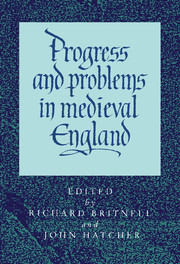Book contents
- Frontmatter
- Contents
- List of figures
- List of maps
- List of tables
- List of contributors
- Edward Miller: an appreciation
- List of abbreviations
- 1 Economic development in the early twelfth century
- 2 Lothian and beyond: the economy of the ‘English empire’ of David I
- 3 Boroughs, markets and trade in northern England, 1000–1216
- 4 Peasant deer poachers in the medieval forest
- 5 The growth of London in the medieval English economy
- 6 The bankruptcy of the Scali of Florence in England, 1326–1328
- 7 The English export trade in cloth in the fourteenth century
- 8 A medieval tax haven: Berwick upon Tweed and the English crown: 1333–1461
- 9 Taxation and communities in late medieval England
- 10 Peasants and the collapse of the manorial economy on some Ramsey Abbey estates
- 11 The famuli in the later Middle Ages
- 12 The great slump of the mid-fifteenth century
- 13 Lorenzo de' Medici's London branch
- 14 The trade of late medieval Chester, 1500–1550
- Bibliography of Edward Miller's published works
2 - Lothian and beyond: the economy of the ‘English empire’ of David I
Published online by Cambridge University Press: 05 June 2012
- Frontmatter
- Contents
- List of figures
- List of maps
- List of tables
- List of contributors
- Edward Miller: an appreciation
- List of abbreviations
- 1 Economic development in the early twelfth century
- 2 Lothian and beyond: the economy of the ‘English empire’ of David I
- 3 Boroughs, markets and trade in northern England, 1000–1216
- 4 Peasant deer poachers in the medieval forest
- 5 The growth of London in the medieval English economy
- 6 The bankruptcy of the Scali of Florence in England, 1326–1328
- 7 The English export trade in cloth in the fourteenth century
- 8 A medieval tax haven: Berwick upon Tweed and the English crown: 1333–1461
- 9 Taxation and communities in late medieval England
- 10 Peasants and the collapse of the manorial economy on some Ramsey Abbey estates
- 11 The famuli in the later Middle Ages
- 12 The great slump of the mid-fifteenth century
- 13 Lorenzo de' Medici's London branch
- 14 The trade of late medieval Chester, 1500–1550
- Bibliography of Edward Miller's published works
Summary
The reigns of Stephen and Matilda (1135–54) witnessed momentous changes on England's northern borders. Within a month of Henry I's death in December 1135 David I, ostensibly supporting his niece the Empress Matilda's claim to the English throne, invaded the realm, initiating a two-phase programme of territorial aggrandisement. Initially, from 1136–8, this resulted in the annexation of Cumberland. Then, after the setbacks following his defeat at the battle of the Standard, it led, during the years 1140/2–51 to the further acquisition of Northumberland and Westmorland proper, to the creation of ‘client states’ in Durham and southern Westmorland or Kentdale and to the extension of Scottish influence deep into Yorkshire. By the mid-twelfth century David had created a vast ‘English empire’, to the south of Lothian, which he and his successor Malcolm IV continued to hold until 1157. He managed, moreover, to settle these territories with a host of knights, drawn largely from the western and southern lands of the English realm. Yet the reasons for either the Scots king's interest in these territories or the attraction they held for would-be immigrants remain obscure, and, accordingly, will be investigated in this essay.
Certainly, in the closing years of Henry I's reign, few would have considered these lands as worthy of much attention. They comprised a remote wilderness whose inhabitants were not noted for their wealth (Map 2.1).
- Type
- Chapter
- Information
- Progress and Problems in Medieval EnglandEssays in Honour of Edward Miller, pp. 23 - 45Publisher: Cambridge University PressPrint publication year: 1996
- 6
- Cited by



